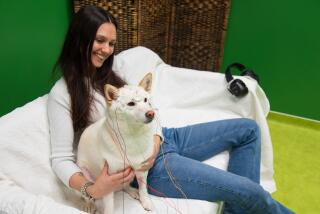How dogs can help unravel genetic diseases in people

- Share via
Dog lovers may be interested in an article published this week in the New England Journal of Medicine: It highlights the discoveries scientists are making about diseases that various dog breeds are prone to -- and how those findings can benefit human health as well as that of canines.
It’s written by longtime dog genetics researcher Elaine Ostrander of the National Human Genome Research Institute.
The discoveries are possible because of several things: First off, both the human genome and dog genomes have been sequenced. (The breeds chosen for the first round of dog DNA sequencing were a standard poodle and boxer, should you be curious.)
Secondly, dogs have been intensively bred into distinct breeds, and in the case of purebreds (though not my black mutt Nightshade; who knows where she came from?) their pedigrees are very well known. Often, the breeds are descended from just a few animals, so they can be very inbred as well.
The intensive selection over the decades and/or centuries for traits of body shape or hair color has also inadvertently selected for genes that foster diseases. And so Bedlington terriers are prone to copper storage diseases, Doberman pinschers are prone to narcolepsy, and so on.
Here is where some lemonade gets made out of that sad lemon: It’s far easier in many cases for scientists to track down genes associated with, say, a cancer or vision disorder in dogs than it is in human beings, Ostrander writes.
That’s especially true when a disease could stem from one of several genetic defects. If you study a bunch of people with the disease, the underlying genes involved will probably be a mix and the results will be too cloudy for scientists to make sense of. But in an inbred dog strain prone to a disorder, the underlying cause is far more likely to be rooted in one specific gene.
And that means scientists can find it. Once they’ve found it, they can then go back and see if the same holds true for some human beings.
Some examples Ostrander cites of gene-influenced disorders in dogs shedding light on diseases in human beings:
--A syndrome called RCND that causes kidney cancer and skin growths in German shepherds was pinpointed to versions of a gene called folliculin. That same gene, it turns out, is involved in a human disease called Birt-Hogg-Dube syndrome.
“The single, large dog pedigree was collected and genotyped in a fraction of the time it took to collect and characterize the many necessary human pedigrees,” Ostrander notes.
--Epilepsy crops up in a lot of different dog breeds, and scientists have found a different underlying genetic cause for miniature wire-haired dachshunds versus Lagotto Romagnolo dogs. Extending the study to other breeds of dogs could expand the list of genes that can be involved in epilepsy, allowing scientists to get a better handle on all the different ways that it can crop up in people.
-- And here’s a gene therapy example. Leber’s congenital amaurosis type 2 is a progressive retinal atrophy in dogs that leads to blindness. It results when a gene called RPE65 is nonfunctional. The disorder was successfully treated by introducing a functional version of the gene to a dog, carried on a virus. The same genetic disease occurs in people, and “humans with Leber’s congenital amaurosis are now being successfully treated for the disorder,” Ostrander writes. (Read about it here at the National Eye Institute website.)
The paper by Ostrander is free to view, if you want to read more about all this.
Read our Science blog at latimes.com/sciencenow and our Health blog at latimes.com/boostershots.
Follow me on twitter: @LATimesRosie





